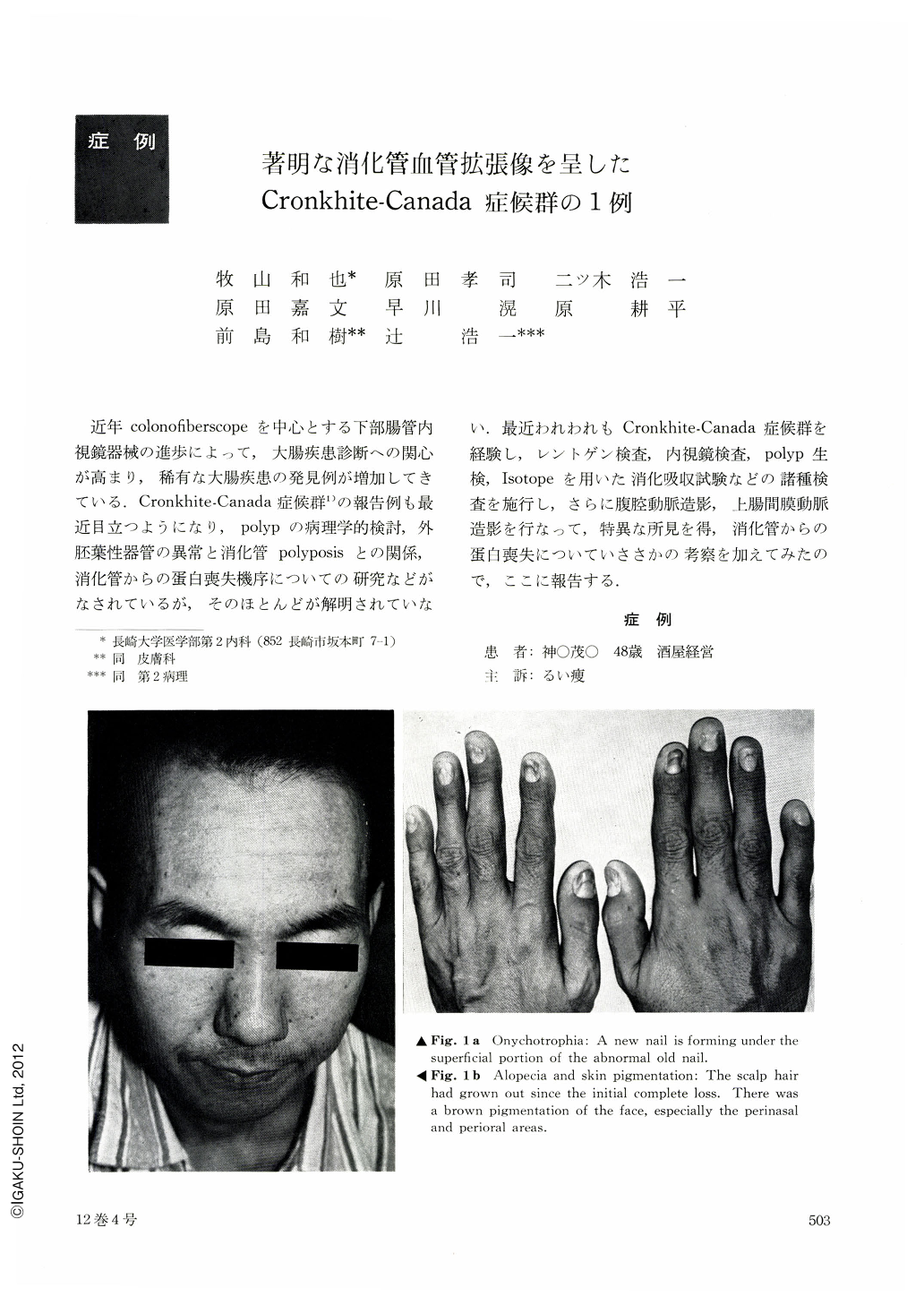Japanese
English
- 有料閲覧
- Abstract 文献概要
- 1ページ目 Look Inside
近年colonofiberscopeを中心とする下部腸管内視鏡器械の進歩によって,大腸疾患診断への関心が高まり,稀有な大腸疾患の発見例が増加してきている.Cronkhite-Canada症候群1)の報告例も最近目立つようになり,polypの病理学的検討,外胚葉性器管の異常と消化管polyposisとの関係,消化管からの蛋白喪失機序についての研究などがなされているが,そのほとんどが解明されていない.最近われわれもCronkhite-Canada症候群を経験し,レントゲン検査,内視鏡検査,polyp生検,Isotopeを用いた消化吸収試験などの諸種検査を施行し,さらに腹腔動脈造影,上腸間膜動脈造影を行なって,特異な所見を得,消化管からの蛋白喪失についていささかの考察を加えてみたので,ここに報告する.
The patient, a forty-year-old man, was admitted to Sasebo Municipal Hospital in June 1972 with symptoms of weight loss and anemia. Except for the usual childhood diseases, he had been well until about 10 months prior to his admission. Initially he noted ageusia, then developed painless watery diarrhea without blood or mucus. Several weeks after onset of diarrhea, he noted alopecia of the scalp and deformity of the fingers and toenails. A diffuse brownish pigmentation appeared over his face, hands and feet. Marked loss of weight (about 14 kg in one month) occurred. There was no family history of intractable diarrhea, alopecia, nail changes, increased pigmentation or polyposis.
Physical examination on admission revealed a well developed and slightly under-nourished male with pale mucus membranes and striking pigmentation of ventral and dorsal surfaces of the hands and feet as well as the buccal area of the face. The fingers and toenails presented a peculiar appearance with atrophy. The scalp hair was sparse, but some had reappeared since the initial loss. The remainder of the physical examination was normal.
Laboratory studies showed a moderate iron deficiency anemia with a hemoglobin of 8.4 g/dl, and hypoproteinemia with a total serum protein of 5.2 g/dl. Gordon's test was abnormal with a value of 1.89%. Glucose tolerance test and serum electrolytes were normal.
G-I series and endoscopic studies showed a large number of sessile and pedunculated polyps distributed throughout the alimentary tract from the stomach to the rectum. These polyps varied considerably in size and shape. The lesions of the stomach and the colon were biopsied by the GF-B and CF-LB instruments. Pathologically the specimens showed adenomatous polyps with proliferation, dilatation, and hyperescretion of glands and edematousstroma without evidence of malignant change. Selective celiac and superior mesenteric angiography by the Seldinger technic showed enlarged caliber and hypervascularization of the gastroduodenal and superior mesenteric arteries.
Here, a case characterized by multiple gastrointestinal polyps, alopecia, atrophy of the nail and pigmentation of the skin, associated with hypoproteinemia due to exudative enteropathy is presented. This case is believed to be Cronkhite-Canada's syndrome because of the findings mentioned previously. An interesting discovery in this case is the angiographic abnormality of the gastroduodenal and superior mesenteric arteries. This suggests the possibility that the protein loss from the digestive tract may be related to the hypervascularization of this portion of the G-I system.

Copyright © 1977, Igaku-Shoin Ltd. All rights reserved.


